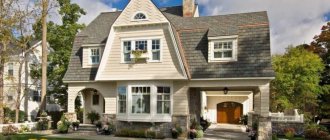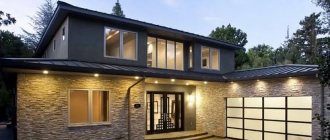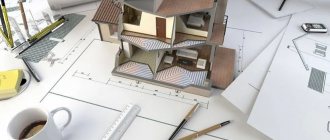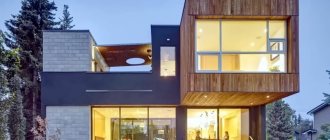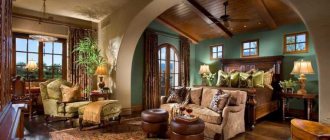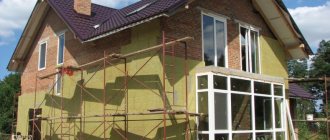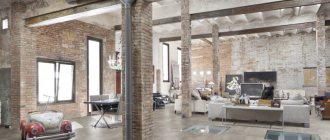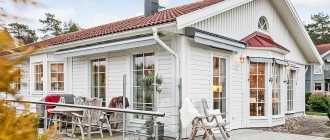Exterior - the artistic or architectural appearance of a one-story or multi-story building, giving the composition a special aesthetic value.
The design of architectural complexes plays an important role and allows us to solve a number of pragmatic and artistic goals. Today, the design of exteriors is done as carefully as the decoration of rooms in the house. In fact, any design company is ready to offer a catalog of unique solutions or develop an individual project that will add aesthetics to any building.
Exterior types by building type
The simplest classification of exterior: design of a single-story building and work with multi-story complexes. Also, trends in building design can be divided into the following two categories:
- Exterior design of a private house;
- Decoration of a private building.
The perfect appearance of the house allows you to create a spectacular landscape design of the site and complement the aesthetic position of the interior of the house. For a public building, the exterior creates a certain aesthetic position and attracts potential customers (advertising function).
Beautiful exteriors of brick houses - photo of a brick house
The beautiful exteriors of brick houses take us to Britain or the USA, where such projects are common in great variety. You can recall the loft style with its simple forms, flat roof and panoramic windows.
But it’s worth considering a more decorative format, where brick is combined with gypsum stucco and complemented with columns. Despite this, the project does not accept the abundance of decor and pomp. On the contrary, straight lines are preserved, conservatism and the monumental signature of the architect are present.
Stylistics of buildings
Like interior solutions, the exterior of buildings can only be developed in accordance with a specific stylistic concept. It is probably impossible to thoroughly compare the supply of a specific direction for the interior space of a house and for the design of the façade of a structure.
Main exterior design styles:
- Ethno;
- High tech;
- Minimalism;
- Modern;
- Gothic;
- Baroque;
- Classic;
- Country;
- Eco style.
Each style is characterized by its own color schemes, decor combinations, and design features. It is also worth noting that the exterior of any building can be presented in a laconic design or decorated with extra-complex designs.
Pilaster and its structure
The architectural elements that make up the pilaster externally resemble a column mounted into the wall. In fact, this is the same thing, except that only the front part of the element is visible on the facade. Structurally, they consist of the following elements:
- Base (base) – the lower main part. Acts as a decorative base for the main part.
- The pillar (trunk) of a pilaster is a long, vertically installed structure (half-column) on which the remaining elements are fixed. The width is significantly smaller than the base.
- Capital - can be regarded as the upper base. According to the principle, the base is made wider than the pillar and is additionally decorated with decorative patterns.
- Abacus is the top square tile. Often decorated with carvings, it can take on various most unimaginable (acceptable to the basic style) forms.
The integrity and harmony of the part is achieved through the combination of all components. This applies to shade, shape, size.
Peter's Baroque pilasters Source moscowchanges.ru
Healthy! This architectural detail does not exert a weight load on the walls, therefore it is widely used for both facades and interior work.
Previously, pilasters were used to strengthen the supporting structure. They had no decorative function, were installed exclusively on facades and were made in a rectangular shape. Only since the Renaissance did the detail acquire a different purpose and become a full-fledged architectural element of the facade, serving a decorative function.
Exterior types according to trends
The exterior, like interior solutions, is constantly undergoing changes. It transforms and adapts to new trends, current trends, and fashion trends. Today we can say with confidence that the design of architectural complexes is divided into two key areas. Here's a quick overview of each:
- Modern approach using technical innovations;
- Eco-style, which involves the use of exclusively simple natural materials and a composition “close to nature.”
Computer equipment, air conditioning systems, technical protection of the house, energy storage elements will make the house more modern and technically comfortable. All gadgets look organically in the stylistic ensembles of modernism, minimalism, and constructivism. Natural components (greenery, original fragments of relief, transparent coatings, specific wall decoration) give the building a special coziness and a sense of peace.
Gable
This is the final part of the facade of the building, portico, colonnade. It is limited by a gable roof on the sides. At the bottom it can rest against the cornice. They may also be present not under roofs, but above a window, door, or porch.
In modern architecture there are 11 types of pediments:
- Keel-shaped - like the bottom of an overturned ship. Characteristic of facades related to Russian architecture.
- Onion - in the shape of an elongated bow.
- Interrupted - having a horizontal cornice that is interrupted for another architectural element, such as a window. In the absence of cornices, it can be placed on gables or columns. In this case, it is called a semi-pediment.
- Broken - cornices that do not connect at the top. They end, leaving free space in which a pedestal for a sculpture or other decoration can be placed.
- Unfastened - parts of which protrude forward.
- Male - made of logs that continue the crown part of the facade.
- Stepped - performed as steps, decreasing in size upward.
- Trapezoidal - made in the shape of a geometric trapezoid.
- Isosceles – corresponding to the shape of an isosceles triangle.
- Pentagonal - attic, installed in the shape of a combined trapezoid.
Pediment of the Kazan Cathedral in St. Petersburg Source cs6.pikabu.ru
Important! From the point of view of visual perception, the pediment is the “face” of the building. Designed to target core personality and style.
Exterior of architectural complexes: main components
The exterior, like the interior compositions, is formed by many elements. Moreover, the composition itself consists of certain components that make the “face of the house.” The exterior of any building can be divided into two components:
- Facade (the decoration of the facade plays an important role);
- Entrance group (a kind of “calling card” of any private house or administrative buildings).
If we talk about restaurants, trading houses, hotels and administrative complexes, it is worth mentioning another important element - brand visualization. Usually these are bright luminous inscriptions that reveal the essence of the brand.
Ornament
The concept of ornament refers to the architectural elements of the facade, intended to visually highlight individual fragments of the building. This can be a window or doorway, an arch, a vault, an interwindow opening, a column, or a wall plane. They can be presented in the form of a carved pattern, with a thematic image corresponding to the style of the building.
Facade ornament Source s61.radikal.ru
Varieties of ornament are characterized by other techniques, the use of various patterns that came from ancient architecture. The most popular types are:
- Celtic, in which preference is given to zigzag, curvilinear and straight lines, and geometric shapes.
- Central Asian with writings interspersed with plant elements.
- Greco-Roman - which became the prototype for decorating buildings of the Renaissance and later Classicism.
- Romanesque - demonstrating a return to the fashion of antiquity and applicable mainly to houses made in the style of medieval castles.
Healthy! In fact, there are 3 categories of ornaments: mimic, imitative and symbolic.
Types of exterior by type of finishing materials
The base of any exterior is a decorated facade. To create an organic composition designed in a certain style, a lot of finishing materials are used. Types of finishing that form a specific exterior composition:
- Profiled sheet;
- Siding;
- Plaster;
- Glass;
- Block house;
- Tree;
- Fake diamond;
- A natural stone;
- Porcelain tiles;
- Brick;
- Tile;
- Stucco;
- Combined options.
Each style has its own set of materials. Stucco and stone are good in classic compositions. Glass, siding and corrugated sheets look organically in the Art Nouveau style exterior. Wood emphasizes the main ideas of eco-trends.
Exterior of a one-story house: how to live simply and tastefully
Are you the owner of a one-story house? Even if you are planning to build a house from scratch, you need to know:
- The exterior of a one-story house requires maximum space saving. The size of the windows should not be too small. Their number on one wall should not exceed 2-3. It is best to choose windows on 50-70% of the wall.
- Brick, wood panels, siding, decorative stone, and a variety of plaster are used as facing materials.
- To make the house seem larger and give a feeling of space, you should select light and pastel colors of the facade. It is recommended to add some color accent (as shown in the photo).
About the entrance group
The entrance group plays an important role in the exterior of luxury private households and in various shopping and entertainment complexes. We are talking about the location of the doors and a convenient approach (or entrance) to them.
All elements of the composition must form a single organic system. They also form an image, set the tone and a certain mood, allow you to quickly identify the social status of the owners of residential apartments or commercial buildings, and study the taste and main preferences of those who were involved in its design.
Socket
The second name this architectural element bears is rosette. It means a decorative element made in the form of petals of a blooming flower with the same shape and size. Relative to each other, they are located evenly and ideally “diverge” from the core, thereby resembling the above-mentioned plant.
Facade rosette in architecture Source cdn.pixabay.com
Installation of architectural façade elements made of polystyrene foam - step-by-step instructions
Let us consider step by step the process of installing architectural elements for the facade made of polystyrene foam.
List of tools
As an introduction, let's look at a list of tools that you may need to do this kind of work.
Table. Installation of architectural facade elements - list of tools.
| Tool name | What is it used for? |
Notched trowel | Applying an adhesive mixture to the wall or the back of a decorative element. |
Narrow spatula | Working with putty or adhesive mixture on narrow areas of decorative elements or on curved surfaces where special precision is required. |
Wide spatula | Applying putty or adhesive mixture to straight and large surfaces of decorative foam elements. |
Mixer attachment for drill | Preparing an adhesive mixture for polystyrene foam decor or mixing putty. |
Buckets and other containers | Preparation and storage of adhesive mixture and putty. |
Building level | Control of the position of the decorative element vertically and horizontally. |
Roulette | Measuring distances. |
Roller and brush | Applying paint to decorative elements and preliminary priming of surfaces for their installation. |
Retractable blade knife | Cutting packaging or small foam parts. |
Machine with hot nichrome thread | Cutting and sawing foam plastic. If missing, replace it with a fine-tooth hacksaw. |
| Scaffolding | For work at heights of more than 2 meters. |
Construction mixer price
Construction mixer
Combined chalet style houses projects
Mountain romance, simplicity and elusive, special beauty lie in houses built in the chalet style. It’s not for nothing that they are called combined, because they are built simultaneously from wood and stone. Thanks to this, such buildings acquire unique properties. Combined chalet-style houses, the designs of which are quite diverse, have long attracted the attention of architects.
Installation of decorative elements on window openings
Start decorating your home with architectural elements from one of the most important parts of any facade - from window and door openings.
Step 1. Prepare the walls and openings themselves for decorating work - complete the construction of all structures, insulate the house and cover the thermal insulation layer with rough finishing. In this case, the cottage is covered with foam boards, which were then covered with reinforcing mesh and plaster.
First you need to prepare the walls
Step 2. All architectural elements of the house presented in this example will be fixed to the walls using a special adhesive composition. For better adhesion, first apply a primer to window openings and other parts of the building where the decor will be attached.
Applying primer
Step 3. Unpack decorative elements for window openings. Check their integrity and completeness. Cut the parts that will be fastened together at the corners of the window openings at an angle of 45°. At home, use a knife with a retractable blade or a hacksaw with fine teeth to do this. And in the image below you can see how a hot nichrome thread is used to perform this task - the best tool for cutting foam, allowing you to achieve a perfectly even cut.
Trimming elements with hot nichrome thread
Important! If you wish and have the appropriate tools, you can produce decorative elements for the facade yourself. To do this, assemble a machine for cutting foam plastic with nichrome thread and prepare metal templates that repeat in their shape the profiles of certain architectural details.
Cutting foam plastic with a hot nichrome thread according to a pre-created metal template
Finished decorative element - interfloor cornice, also known as molding
Step 4. Prepare an adhesive mixture for installing polystyrene foam parts.
Preparation of adhesive mixture for polystyrene foam
Prices for Ceresit glue
Ceresit glue
Step 5. Apply a layer of glue on the surface near the window openings, where decorative polystyrene foam elements will subsequently be applied. Use a notched trowel to do this job.
Applying the adhesive mixture with a notched trowel
Step 6. Apply a thin layer of adhesive mixture to the back of the foam decorative piece that you are currently going to install on the facade.
Glue is applied to the decorative element
Step 7. Install decorative trims on the window openings. As was already shown in the previous step, apply glue to the wall itself and the same, but in a thin layer, to the part itself. Then place it in the desired location and press firmly. Level the position manually or using a building level and move on to the rest of the decorative trim.
Platband installation
The casing is pressed against the wall
Step 8. Perform similar actions with other decorative elements of the openings - window sill and cornice.
Installing a window sill
The window opening is decorated
Step 9. Install decorative foam elements using an adhesive mixture on the balcony opening.
Decorative elements are installed on the balcony opening
Step 10. Attach keystones and other particularly complex decorative elements for openings to pre-marked places. As a rule, they are installed after reinforcement and puttying of platbands, cornices and other similar parts.
Fastening the keystone
Check the horizontal position of the keystone using a building level
Prices for building levels
Construction levels
Installing decorative elements on walls and corners
Now let's move on to the wall decorative elements of the facade. In this case, interfloor molding and corner rustication are installed.
Step 1. Along the perimeter of the walls, measure a perfectly straight horizontal line at the transition between the first and second floors. Display it strictly according to the building level indications.
The transition between floors is indicated by a straight line
Step 2. Along the previously drawn line, apply a strip of adhesive mixture, comparable in height to the decorative element being installed. As with window openings, use a notched trowel.
Applying the adhesive mixture
Step 3. Apply a thin layer of adhesive mixture to the back of one of the pieces of deck molding, and then glue that piece into place. Start this work from one of the corners of the building.
Gluing part of the interfloor molding
Step 4. Install this part of the interfloor molding on the other side of the corner. To join with the previous element, cut their edges at an angle of 45° in advance.
Installation of the second part of the molding
Step 5. Install the remaining parts of the interfloor molding. At the same time, tightly join them to each other and be sure to check that the horizontal position is consistent with the building level.
Checking the horizontality of molding elements
Important! If for some reason the gap between two adjacent foam elements becomes too large, treat the joint with a special adhesive mixture.
Step 6. Calculate in advance on paper at what heights relative to the ground the corner rustication elements will be located.
The diagram must be drawn in advance
Step 7. Using a ruler and level, transfer the numbers from the plan to the corners themselves - make the necessary marks.
The required marks are placed
Step 8. In front of that part of the rustication that will be adjacent to the base, secure the reinforcing mesh - apply the adhesive mixture, sink the mesh into it and cover it with the same mixture on top.
The reinforcing mesh is covered with an adhesive mixture
Step 9. Apply the adhesive mixture to the back side of one of the rustication elements and press it tightly to the installation site, guided by the pre-made marks.
Applying glue to a rustic element
Fixing an element
Step 10. Repeat the previous step and install all rustication elements. The same principles are used to install other decorative foam products on the façade of the house.
The rest of the rustication elements are fixed
Scaffolding prices
Scaffolding
Facade decor
Today's buildings have minimal decoration.
Beautiful houses are now being built by country property owners. Private cottages impress with their variety of shapes and decorations. Facade decor is a non-structural part. These are decorations that make a building unique. They stylize, emphasize the status of the owner, and demonstrate the designer’s skill. Facades are divided according to purpose:
- main,
- rear,
- yard,
- side,
- park,
- street.
As a rule, the most architectural elements are on the main facade
Building decor elements
Based on their purpose, design elements are divided into two groups.
- Active decor - based on the shape and design of the building. Corresponds to the purpose and dimensions.
- Passive decor - intended solely to decorate the appearance, and is not associated with division or form.
To create a harmonious appearance of the facade, basic knowledge of the names and purposes of architectural decorations is required. The parts are used on windows and wall purlins. They distinguish the horizontal of the roof, the corners of the house, and the interfloor space.
Location and name of elements
The division of the facade with decor implies vertical and horizontal:
Decorative design with columns redirect
redirect('/stati/arhitekturnye_elementy_dekora/dekorativnoe_oformlenie_kolonnami1/')%
Columns on the facades of buildings and interiors since the times of Ancient Rome symbolize severity, solemnity, and formality.
Columns on the facade of the Vittoriano - a monument in honor of the first king of a united Italy, Victor Emmanuel II (1885 -1935). Piazza Venezia in Rome.
A column in architecture is a vertical support that has three main parts: the base, the trunk and the upper part - the capital. The decorative design of the column is based on the order system to which it belongs.
The modern column base is made of polyurethane.
The column trunk is made of polyurethane, which is usually used to decorate load-bearing supports.
A modern embodiment of an Ionic order column capital made of polyurethane.
In ancient times, columns were built during the construction of facades, pavilions, gazebos, and rotundas to support the vaults of galleries and arches. The column can perform both load-bearing functions and be decorative. The design of the columns is based on the style and idea that this type of building decoration should convey to the viewer. Vitruvius - author of "Ten Books on Architecture", Roman architect and engineer of the 2nd half of the 1st century. BC e. compared the columns with the human body. In his writings he describes the origin of different orders. For example, he wrote that the height of a Doric column is six of its diameters and draws attention to the fact that the length of an adult man’s leg can be equated to six the length of his foot. From this comparison, the architect concluded that a similar ratio was adopted by the ancient Greeks as the basis for creating columns. The Doric order, according to Vitruvius, has a masculine character, so the design of the columns is practically absent. Ionic columns were more elegant than Doric ones and were decorated with currencies resembling a woman's hairstyle. In his description of the Ionic columns of the Temple of Diana, Vitruvius, drawing analogies with the human body, says that the basis for the ratio of height and thickness (the thickness of the columns is 1/8 of the height) is not the male foot, as in the Doric ones, but the female foot. This proportion gives the column slenderness. Vitruvius compared the decorative design of the Ionic order columns with the modest jewelry of a young girl, drawing an analogy with the concepts of “tenderness and severity,” as well as with Juno and Diana from ancient mythology. He compares the base to a shoe, the volutes of a capital to curls, and the flutes to the folds of a dress.
Proportions of an Ionic column capital from Fundamentals of Architecture, edited by Emily Cole.
Vitruvius identified the columns of the Corinthian order with a mature lady who loved accessories (the design of Corinthian columns - leaves, curls, fruits, flowers), drawing a comparison with the goddesses Venus and Flora.
Column capitals of the Doric, Ionic, Corinthian order.
Abacus - a quadrangular slab (regular or with truncated corners) - the upper part of the capital. The leaves protrude to the sides to support volutes, the size of which reaches the end of the abacus, and the flowers are made according to the thickness of the abacus.
The decorative design of the columns of the Corinthian order is based on Dorian or Ionic proportions, since the Corinthian order did not have its own proportionality in the arrangement of the decor. In the decorative design of columns, the main attention is paid to proportions.
The capital minus the thickness of the abacus (1/7 of the height of the capital) is divided into three parts: one part is occupied by the bottom sheet of decor, in the middle part - the second sheet. The stems at the base of the leaves are the same size.
Construction of the capital of a Roman Corinthian column.
Construction of a column of the Corinthian order according to Vignola (Italian theorist and architect Giacomo Barozzi da Vignola (Il Vignola; real name Jacopo de Barozzi; 1507-1573)
This design of the columns makes them, according to Vitruvius, perfect. Other types of column designs are created on the basis of the existing three. Each historical style, based on the classics, implies columns of a certain type. Corinthian or combination columns with smooth shafts or flutes are suitable for Roman style buildings.
The columns of Ancient Rome still amaze with their dimensions and decor.
If a building is being built in the Empire style, then richly decorated columns with bas-reliefs and magnificent capitals of the Corinthian order are appropriate. Rococo style and decoration in modern construction rarely quotes ancient examples, so curved or twisted columns in the design of buildings are extremely rare, but they are used for interiors made in these lush styles.
Twisted columns of the altar of St. Peter's Basilica in Rome in the Baroque style.
When decorating buildings and interiors, you can follow the path of ethno-styles and use the design of columns for this. The Egyptian style is characterized by lotus-shaped columns and pillars with inscribed hieroglyphs. The antique Greek style of a building or interior can be supported by decorating the columns with emblems symbolizing love - dolphins, fish. In the Indian tradition, a column with a crown is a symbol of spiritual ascent. Most often in modern construction, classicism style columns are used, close to the Ionic order or with elements of the Corinthian order. Load-bearing columns are made of stone: granite, marble, tuff, sandstone, as well as concrete, wood, and steel. Decorative columns that do not carry loads are created from a variety of materials, including glass, metal, plastic, and polymer materials. Recently, in facade and interior decor, preference is increasingly being given to columns made of polyurethane. This is a lightweight and durable material, it is not afraid of moisture, temperature changes, products made from it can imitate any natural material. Polyurethane columns are assembled from parts, so they are convenient to transport and install. The decorative design of polyurethane columns is selected from finished product catalogs.
The column capital with Corinthian style motifs made of polyurethane does not differ in appearance from plaster.
A wide variety of building and interior styles can be supported by columns and their design by choosing the appropriate decor.
Text author: M. Sergeeva
